introductory guidance notes
 Alexander Solzhenitsyn (1918-2008 ) was both the continuation of the nineteenth century Russian realist literary tradition, and the nearest the twentieth century had to a Tolstoy figure – a great writer who became a self-appointed conscience to the Russian nation. Solzhenitsyn survived four of the most severe tests known to human beings – war, cancer, unjust imprisonment, and exile. He made all of them the materials of his fiction. He was awarded the Nobel Prize for Literature in 1970. This did not prevent him being expelled from the Soviet Union in 1974 under Brezhnev. He then lived in the United States until he was invited back to his homeland in 1994 following the collapse of communism.
Alexander Solzhenitsyn (1918-2008 ) was both the continuation of the nineteenth century Russian realist literary tradition, and the nearest the twentieth century had to a Tolstoy figure – a great writer who became a self-appointed conscience to the Russian nation. Solzhenitsyn survived four of the most severe tests known to human beings – war, cancer, unjust imprisonment, and exile. He made all of them the materials of his fiction. He was awarded the Nobel Prize for Literature in 1970. This did not prevent him being expelled from the Soviet Union in 1974 under Brezhnev. He then lived in the United States until he was invited back to his homeland in 1994 following the collapse of communism.
Most of his work is written in a simple, spare manner in which ornamentation is stripped away in favour of moral purpose. The results celebrate a stoical, almost puritan heroism in the face of all that the Russian people have had to endure – constructed poverty, war, political corruption, censorship, and totalitarian repression.
In his later years, just like Tolstoy, he abandoned literature in favour of writing moralising polemical works concerned with religious and political issues, and he is generally regarded as having drifted into something of a reactionary. However, his earlier work is well worth serious consideration.
 One Day in the Life of Ivan Denisovitch (1962) is a short novel that made Solzhenitsyn famous overnight. It recounts a typical day’s work, deprivation, and suffering of a prisoner in one of Stalin’s labour camps. Publication was ‘allowed’ because it suited Krushchev in his post 1956 reforms and his criticism of Stalin. The facts of prison camp life were deliberately understated to meet the censor’s requirements. It catapulted Solzhenitsyn to fame, and yet within two or three years his work was banned all over again. Beginners should start here.
One Day in the Life of Ivan Denisovitch (1962) is a short novel that made Solzhenitsyn famous overnight. It recounts a typical day’s work, deprivation, and suffering of a prisoner in one of Stalin’s labour camps. Publication was ‘allowed’ because it suited Krushchev in his post 1956 reforms and his criticism of Stalin. The facts of prison camp life were deliberately understated to meet the censor’s requirements. It catapulted Solzhenitsyn to fame, and yet within two or three years his work was banned all over again. Beginners should start here.
![]() Buy the book from Amazon UK
Buy the book from Amazon UK
![]() Buy the book from Amazon US
Buy the book from Amazon US
 The Gulag Archipelago (1973-1978) could eventually turn out to be Solzhenitsyn’s masterpiece. It’s a three-volume encyclopedia of the forced labour camps which underpinned the communist system – from Lenin onwards. It was written in secret under incredibly difficult conditions and smuggled out to the West. It’s a history, a sociology, a complete political and social record of the labour camps. Rather unusually for Solzhenitsyn it is recounted via a series of poetic metaphors which hold together a wonderful collection of stories, statistics, and anecdotes. There are heartbreaking tales of endurance, survival, escape, and recapture. It is truly one of the great documents of historical witness. In retrospect it probably helped to bring about the collapse of the totally corrupt communist regime in the USSR. But most importantly it helps to document a tragically bleak period of quite recent European history. This is a work which could significantly affect your life.
The Gulag Archipelago (1973-1978) could eventually turn out to be Solzhenitsyn’s masterpiece. It’s a three-volume encyclopedia of the forced labour camps which underpinned the communist system – from Lenin onwards. It was written in secret under incredibly difficult conditions and smuggled out to the West. It’s a history, a sociology, a complete political and social record of the labour camps. Rather unusually for Solzhenitsyn it is recounted via a series of poetic metaphors which hold together a wonderful collection of stories, statistics, and anecdotes. There are heartbreaking tales of endurance, survival, escape, and recapture. It is truly one of the great documents of historical witness. In retrospect it probably helped to bring about the collapse of the totally corrupt communist regime in the USSR. But most importantly it helps to document a tragically bleak period of quite recent European history. This is a work which could significantly affect your life.
![]() Buy the book from Amazon UK
Buy the book from Amazon UK
![]() Buy the book from Amazon US
Buy the book from Amazon US
 The First Circle (1968) is set in a special research-cum-detention centre reserved for mathematicians and scientists who are nevertheless political prisoners. This is what might be called a novel of ideas, as the characters discuss the political and historical forces which have brought them to their present unjust imprisonment. Of the main characters, one is eventually released, another is sent off to a much harsher regime, and the third remains where he is. Includes a satirical portrait of Stalin.
The First Circle (1968) is set in a special research-cum-detention centre reserved for mathematicians and scientists who are nevertheless political prisoners. This is what might be called a novel of ideas, as the characters discuss the political and historical forces which have brought them to their present unjust imprisonment. Of the main characters, one is eventually released, another is sent off to a much harsher regime, and the third remains where he is. Includes a satirical portrait of Stalin.
![]() Buy the book from Amazon UK
Buy the book from Amazon UK
![]() Buy the book from Amazon US
Buy the book from Amazon US
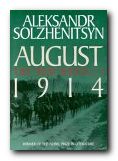 August 1914 (1971) is the first part of a multi-volume epic, a historical novel on a grand scale about the origins of the Soviet Union and how communism came to take root there. The cycle is called The Red Wheel, and was never finished. Solzhenitsyn sees the Battle of Tannenberg at the start of the First World War as the first major turning point in this process. Using a range of modernist and vaguely experimental techniques, he sets in motion a huge cast of characters against the backdrop of this decisive battle.
August 1914 (1971) is the first part of a multi-volume epic, a historical novel on a grand scale about the origins of the Soviet Union and how communism came to take root there. The cycle is called The Red Wheel, and was never finished. Solzhenitsyn sees the Battle of Tannenberg at the start of the First World War as the first major turning point in this process. Using a range of modernist and vaguely experimental techniques, he sets in motion a huge cast of characters against the backdrop of this decisive battle.
![]() Buy the book from Amazon UK
Buy the book from Amazon UK
![]() Buy the book from Amazon US
Buy the book from Amazon US
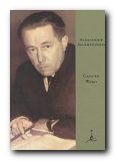 Lenin in Zurich (1976) is a short section from The Red Wheel which focuses largely on Lenin in exile, immediately prior to his triumphant return in a sealed train to St Petersburg’s Finland Station. It’s a very interesting study, because Solzhenitsyn is clearly critical of Lenin as one of the central architects of communism – yet he narrates the novel largely from Lenin’s point of view, blending a psychological character study and real historical detail with a witheringly ironic critique. Steeped in history, this is a major attempt at a political and psychological portrait of a historical figure.
Lenin in Zurich (1976) is a short section from The Red Wheel which focuses largely on Lenin in exile, immediately prior to his triumphant return in a sealed train to St Petersburg’s Finland Station. It’s a very interesting study, because Solzhenitsyn is clearly critical of Lenin as one of the central architects of communism – yet he narrates the novel largely from Lenin’s point of view, blending a psychological character study and real historical detail with a witheringly ironic critique. Steeped in history, this is a major attempt at a political and psychological portrait of a historical figure.
![]() Buy the book from Amazon UK
Buy the book from Amazon UK
![]() Buy the book from Amazon US
Buy the book from Amazon US
© Roy Johnson 2009
 Nadine Gordimer (1923—2014) was born into a privileged white middle-class family in the Transvaal, South Africa. She began reading at an early age, and published her first story in a magazine when she was only fifteen. Her wide reading informed her about the world on the other side of apartheid – the official South African policy of racial segregation – and that discovery in time developed into strong political opposition to apartheid. She attended the University of Witwatersrand for one year. Her first book was a collection of short stories, The Soft Voice of the Serpent (1952). In addition to writing, she lectured and taught at various schools in the United States during the 1960s and 1970s. She was awarded the Nobel prize for Literature in 1991.
Nadine Gordimer (1923—2014) was born into a privileged white middle-class family in the Transvaal, South Africa. She began reading at an early age, and published her first story in a magazine when she was only fifteen. Her wide reading informed her about the world on the other side of apartheid – the official South African policy of racial segregation – and that discovery in time developed into strong political opposition to apartheid. She attended the University of Witwatersrand for one year. Her first book was a collection of short stories, The Soft Voice of the Serpent (1952). In addition to writing, she lectured and taught at various schools in the United States during the 1960s and 1970s. She was awarded the Nobel prize for Literature in 1991. The Conservationist (1974) concerns a white industrialist who farms his land (with native help) at the weekend and genuinely wants to make his presence a positive contribution. But most of all he wants to preserve his power and his privileged way of life – despite being surrounded by poverty and suffering. He just doesn’t understand that the indigenous population are the natural owners of the land, and the result is disastrous – for him.
The Conservationist (1974) concerns a white industrialist who farms his land (with native help) at the weekend and genuinely wants to make his presence a positive contribution. But most of all he wants to preserve his power and his privileged way of life – despite being surrounded by poverty and suffering. He just doesn’t understand that the indigenous population are the natural owners of the land, and the result is disastrous – for him.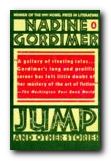 Jump Her development as a writer of short stories is wonderful. She starts off in modern post-Checkhovian mode presenting situations which have little drama but which invite the reader to contemplate states of being or moods which illustrate the ideologies of South Africa. Technically, Nadine Gordimer experiments heavily with point of view, narrative perspective, unexplained incidents, switches between internal monologue and third person narrative (rather like Virginia Woolf) and a heavy use of ‘as if’ prose where narrator-author boundaries become very blurred.
Jump Her development as a writer of short stories is wonderful. She starts off in modern post-Checkhovian mode presenting situations which have little drama but which invite the reader to contemplate states of being or moods which illustrate the ideologies of South Africa. Technically, Nadine Gordimer experiments heavily with point of view, narrative perspective, unexplained incidents, switches between internal monologue and third person narrative (rather like Virginia Woolf) and a heavy use of ‘as if’ prose where narrator-author boundaries become very blurred. Selected Stories As her work matured, her style and methods underwent a similar development to those of Virginia Woolf. Some of her stories became more lyrical, more compacted and symbolic, abandoning any semblance of conventional story or plot in favour of a poetic meditation on a theme. There are some stories which make enormous demands upon the reader. Sometimes on first reading it’s even hard to know what is going on. But gradually a densely concentrated image or an idea will emerge – the equivalent of a Joycean ‘epiphany’ – and everything falls into place. Her own collection of Selected Stories are UK National Curriculum recommended reading.
Selected Stories As her work matured, her style and methods underwent a similar development to those of Virginia Woolf. Some of her stories became more lyrical, more compacted and symbolic, abandoning any semblance of conventional story or plot in favour of a poetic meditation on a theme. There are some stories which make enormous demands upon the reader. Sometimes on first reading it’s even hard to know what is going on. But gradually a densely concentrated image or an idea will emerge – the equivalent of a Joycean ‘epiphany’ – and everything falls into place. Her own collection of Selected Stories are UK National Curriculum recommended reading.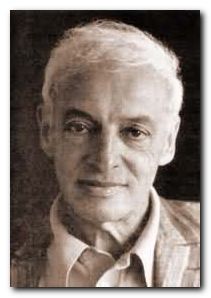 Saul Bellow (1915—2005) was born of Russian-Jewish parents in Canada, but lived most of his life in Chicago, a city which features in many of his novels. His work features characters struggling to understand themselves, and searching for identity in an often irrational world. He has a wonderful ear for the rhythms of modern speech, and he captures city life particularly well. Linguistically, he manages to successfully combine an intellectual-philosophical vocabulary with the language of the street. And his narratives are often very funny. He was awarded the Nobel Prize in 1976.
Saul Bellow (1915—2005) was born of Russian-Jewish parents in Canada, but lived most of his life in Chicago, a city which features in many of his novels. His work features characters struggling to understand themselves, and searching for identity in an often irrational world. He has a wonderful ear for the rhythms of modern speech, and he captures city life particularly well. Linguistically, he manages to successfully combine an intellectual-philosophical vocabulary with the language of the street. And his narratives are often very funny. He was awarded the Nobel Prize in 1976. Dangling Man (1944) his first novel, is concerned with existential philosophy and the sense of identity which was much in vogue at the time of its publication. It’s an accomplished debut, thoughtful and serious, about a man who does not want to go into the army. This reflects the serious side of Bellow, who repeatedly inspects the human condition. But it doesn’t have much of the rib-tickling bravura of his later work. This is early Bellow flexing his wings. It is perhaps best appreciated after you have read some of his later works.
Dangling Man (1944) his first novel, is concerned with existential philosophy and the sense of identity which was much in vogue at the time of its publication. It’s an accomplished debut, thoughtful and serious, about a man who does not want to go into the army. This reflects the serious side of Bellow, who repeatedly inspects the human condition. But it doesn’t have much of the rib-tickling bravura of his later work. This is early Bellow flexing his wings. It is perhaps best appreciated after you have read some of his later works.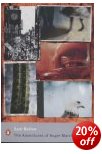 The Adventures of Augie March is an ambitious, rambling, almost picaresque novel. Its first half is a moving and seemingly authentic account of a young boy growing up in Chicago during the Depression – which is where Bellow himself was raised. The story then goes off in a free-wheeling account of a series of bizarre jobs and relationships, and he ends up in Mexico. Bellow’s purpose seems to be to question how much compromise is desirable and how much is necessary, and what make us think about which parts of ourselves we want to remain individual. The second half of the novel however is far less coherent and less credible than the first – but some critics think otherwise.
The Adventures of Augie March is an ambitious, rambling, almost picaresque novel. Its first half is a moving and seemingly authentic account of a young boy growing up in Chicago during the Depression – which is where Bellow himself was raised. The story then goes off in a free-wheeling account of a series of bizarre jobs and relationships, and he ends up in Mexico. Bellow’s purpose seems to be to question how much compromise is desirable and how much is necessary, and what make us think about which parts of ourselves we want to remain individual. The second half of the novel however is far less coherent and less credible than the first – but some critics think otherwise. Seize the Day (1956) is a novella in which you get a sense of Bellow finding his true voice. It’s a light, swift work with dark shadows that looks at the events of one day in the life of Tommy Wilhelm, a fading charmer. He confronts his sense of personal failure and a love-hate relationship with his father. This is his day of reckoning and he is scared. In his 40s, he still retains a boyish impetuousness that has brought him to the brink of havoc. In the course of this one climatic day, he reviews his past mistakes and spiritual malaise. This is a short work which is held together by the sort of concentrated sense of unity which is the hallmark of a good novella. It is now widely regarded as the first of Bellow’s great works.
Seize the Day (1956) is a novella in which you get a sense of Bellow finding his true voice. It’s a light, swift work with dark shadows that looks at the events of one day in the life of Tommy Wilhelm, a fading charmer. He confronts his sense of personal failure and a love-hate relationship with his father. This is his day of reckoning and he is scared. In his 40s, he still retains a boyish impetuousness that has brought him to the brink of havoc. In the course of this one climatic day, he reviews his past mistakes and spiritual malaise. This is a short work which is held together by the sort of concentrated sense of unity which is the hallmark of a good novella. It is now widely regarded as the first of Bellow’s great works.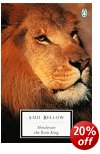 Henderson the Rain King (1959) was his first major success. It is a comic character study of American millionaire Gene Henderson, a larger-than-life 55-year-old who has accumulated money, position, and a large family, yet nonetheless feels unfulfilled. The story plots his frustrations with modern life, and his quest for revelation and spiritual enlightenment in Africa, where he fights with a lion, is hailed as a rainmaker, and becomes heir to a kingdom. He meets two tribes, one of which he virtually destroys in an attempt to purify their main water supply of a plague of frogs which goes disastrously wrong. Much of the novel’s humour derives from such antics from Henderson, a character-exaggeration clearly based on Ernest Hemingway (who was a highly regarded writer and public figure at the time).
Henderson the Rain King (1959) was his first major success. It is a comic character study of American millionaire Gene Henderson, a larger-than-life 55-year-old who has accumulated money, position, and a large family, yet nonetheless feels unfulfilled. The story plots his frustrations with modern life, and his quest for revelation and spiritual enlightenment in Africa, where he fights with a lion, is hailed as a rainmaker, and becomes heir to a kingdom. He meets two tribes, one of which he virtually destroys in an attempt to purify their main water supply of a plague of frogs which goes disastrously wrong. Much of the novel’s humour derives from such antics from Henderson, a character-exaggeration clearly based on Ernest Hemingway (who was a highly regarded writer and public figure at the time). Herzog (1964) became highly regarded and a classic almost as soon as it was published. It centres intensely on the life of Moses Herzog, a Jewish intellectual who is driven close to the verge of breakdown by the adultery of his second wife with his close friend. He writes letters to famous people, both living and dead – Spinoza, Nietzsche, Winston Churchill, and the President of the USA – giving them a piece of his mind and asking their advice about how to live. The novel begins with a statement which sets the tone for everything that follows: “If I am going out of my mind, it’s all right with me, thought Moses Herzog”.
Herzog (1964) became highly regarded and a classic almost as soon as it was published. It centres intensely on the life of Moses Herzog, a Jewish intellectual who is driven close to the verge of breakdown by the adultery of his second wife with his close friend. He writes letters to famous people, both living and dead – Spinoza, Nietzsche, Winston Churchill, and the President of the USA – giving them a piece of his mind and asking their advice about how to live. The novel begins with a statement which sets the tone for everything that follows: “If I am going out of my mind, it’s all right with me, thought Moses Herzog”. Humboldt’s Gift (1974) traces the life and memories of writer Charlie Citrine as he reflects on the influence of his boyhood friend and mentor, Humboldt. This character is based loosely upon Delmore Schwartz, the Jewish poet and short story writer whose early promise was never fulfilled. He descended into alcoholism and poverty, and died in a cheap hotel room, creating the modern version of the myth of the ‘doomed poet’. The novel deals with the ‘gift’ for aesthetic appreciation he passes on to his close friend Charlie, the narrator of the novel.
Humboldt’s Gift (1974) traces the life and memories of writer Charlie Citrine as he reflects on the influence of his boyhood friend and mentor, Humboldt. This character is based loosely upon Delmore Schwartz, the Jewish poet and short story writer whose early promise was never fulfilled. He descended into alcoholism and poverty, and died in a cheap hotel room, creating the modern version of the myth of the ‘doomed poet’. The novel deals with the ‘gift’ for aesthetic appreciation he passes on to his close friend Charlie, the narrator of the novel. Ravelstein (2000) is something of a double portrait. Abe Ravelstein, a mega-successful Jewish academic realises that he might be dying. He invites his friend Chick to write an biographical study of him. What we get is a not-so-thinly disguised portrait of the critic Allan Bloom written by a character who has had all the brushes with life which Bellow experienced in his own: near-death illness, late-life divorce, and happiness with a new wife. Since his death, it has become a lot clearer just how much of his own life Bellow put into his fiction.
Ravelstein (2000) is something of a double portrait. Abe Ravelstein, a mega-successful Jewish academic realises that he might be dying. He invites his friend Chick to write an biographical study of him. What we get is a not-so-thinly disguised portrait of the critic Allan Bloom written by a character who has had all the brushes with life which Bellow experienced in his own: near-death illness, late-life divorce, and happiness with a new wife. Since his death, it has become a lot clearer just how much of his own life Bellow put into his fiction.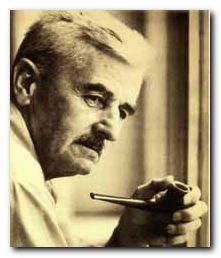 William Faulkner (1897—1962) grew up in Oxford, Mississippi, and lived there for the rest of his life – with only brief intermissions for travel and working in Hollywood as a screenwriter. He was one of the major American writers of the early twentieth century. He established the white protestant version of the American south, reflecting its values of that period – the collapse of the white land owning aristocracy and the inability (at that time) of the blacks to shake off the legacy of slavery. Faulkner was a literary experimentalist, influenced by the modernist period, and he sometimes makes extreme demands on his readers. He uses stream of consciousness, fragmented chronology, shifting point of view, and multiple narrative voices. Even in some of his plain narratives, the story is expressed in sentences which sometimes go on for two or three pages at a time.
William Faulkner (1897—1962) grew up in Oxford, Mississippi, and lived there for the rest of his life – with only brief intermissions for travel and working in Hollywood as a screenwriter. He was one of the major American writers of the early twentieth century. He established the white protestant version of the American south, reflecting its values of that period – the collapse of the white land owning aristocracy and the inability (at that time) of the blacks to shake off the legacy of slavery. Faulkner was a literary experimentalist, influenced by the modernist period, and he sometimes makes extreme demands on his readers. He uses stream of consciousness, fragmented chronology, shifting point of view, and multiple narrative voices. Even in some of his plain narratives, the story is expressed in sentences which sometimes go on for two or three pages at a time.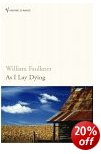 As I Lay Dying (1930) is a good point to start. It charts the journey of a poor family to bury their mother Addie Bundren in Jefferson. They make the coffin themselves and survive crossing the flooded Yoknapatwapha river, a fire, and other largely self-inflicted problems, to finally reach their goal. The novel is told in the rapidly intercut voices of the family members – including the dead mother. It is simultaneously funny, and tragic – a small scale epic which Faulkner wrote in the space of six weeks.
As I Lay Dying (1930) is a good point to start. It charts the journey of a poor family to bury their mother Addie Bundren in Jefferson. They make the coffin themselves and survive crossing the flooded Yoknapatwapha river, a fire, and other largely self-inflicted problems, to finally reach their goal. The novel is told in the rapidly intercut voices of the family members – including the dead mother. It is simultaneously funny, and tragic – a small scale epic which Faulkner wrote in the space of six weeks. The Sound and The Fury is generally regarded as his greatest work. It is a narrative tour de force in which Faulkner views the decline of the south through the point of view of four characters. The novel centres on the once-aristocratic Compson family, who appear in his other novels. The siblings Quentin and Caddy fall from a state of innocence and succumb to the family pattern of incest, erotomania, and suicide. One of their brothers is severely mentally handicapped. The first part of the novel is told entirely from his point of view – and of course he ‘sees’ the truth of much that is going on. The other narrator is the black servant who is powerless but ‘endures’. It is a work of astonishing brilliance, written in a sombre and lyrical mood.
The Sound and The Fury is generally regarded as his greatest work. It is a narrative tour de force in which Faulkner views the decline of the south through the point of view of four characters. The novel centres on the once-aristocratic Compson family, who appear in his other novels. The siblings Quentin and Caddy fall from a state of innocence and succumb to the family pattern of incest, erotomania, and suicide. One of their brothers is severely mentally handicapped. The first part of the novel is told entirely from his point of view – and of course he ‘sees’ the truth of much that is going on. The other narrator is the black servant who is powerless but ‘endures’. It is a work of astonishing brilliance, written in a sombre and lyrical mood.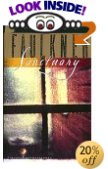 Sanctuary (1931) is an example of Faulkner writing simultaneously at his best and worst. The novel was produced to make money, and is a sort of rural South whodunit which centres on a particularly grizzly crime. All the southern Gothic elements are here. The main plot revolves around Temple Drake, a coquettish college girl who likes to secretly sneak out of her college dorm to attend dances. She takes one step too far onto the wild side, and the result is a helter-skelter ride down into the moral abyss. The novel also includes a psychopathic bootlegger, corrupt local officials, the trial of an innocent man, and a public lynching. It was Faulkner’s only best-seller.
Sanctuary (1931) is an example of Faulkner writing simultaneously at his best and worst. The novel was produced to make money, and is a sort of rural South whodunit which centres on a particularly grizzly crime. All the southern Gothic elements are here. The main plot revolves around Temple Drake, a coquettish college girl who likes to secretly sneak out of her college dorm to attend dances. She takes one step too far onto the wild side, and the result is a helter-skelter ride down into the moral abyss. The novel also includes a psychopathic bootlegger, corrupt local officials, the trial of an innocent man, and a public lynching. It was Faulkner’s only best-seller.